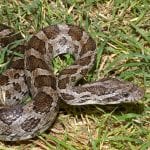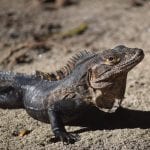Scientific Facts
| Common Name: | Tricolor hognose snake |
| Scientific Name: | Xenodon pulcher |
| Life Span: | 8 years |
| Size: | 18 to 24 inches |
| Habitat: | Wetlands and rainforests |
| Country of Origin: | South America |
Physical Description
Tricolor hognose snakes are short colubrid snakes that originated in South America. They’ve been found living in Argentina, Brazil, Bolivia, and Paraguay. These snakes are trying to mimic the venomous coral snakes as their basic defense mechanism. They also mimic the milk snakes as they have those black, white, and red-ringed patterns.
Their shape and size, aside from their colors, feeding response, behavior, and upturned hog noses, are the most common reasons behind their rising popularity. Adults often reach a length of 18 to 24 inches.
Habitat
These snakes love to burrow while they prefer to be in semi-humid areas. Their homes are mostly near the rivers, lakes, streams, and other bodies of water.
Life Span
Unlike other popular snake species, the tricolor hognose snakes can last for up to 8 years only. With proper handling and husbandry, these snakes may live a bit longer than that.
Breeding
Mating is most likely to occur when you keep male and female snakes together. You have nothing to do to make it happen. For as long as your pets are healthy and they stay in good condition, mating will occur naturally. You just have to consider if you want that to occur before you introduce the pair. What would you do to the baby snakes when incubating the eggs?
Gravid females must have easy access to the nesting spot to lay the eggs. This box must be big enough so that they can turn around in it. You can fill the nesting box with a soil mix that is adequately humid to maintain the shape. At the same time, it should not too wet that can saturate the eggs.
The incubating eggs must be kept at the ideal temperature of 84 degrees Fahrenheit. You may incubate the eggs in the closed boxes on the moisture-rich substrate in trapping the humidity surrounding the eggs. Then, the eggs will hatch in the 60 days. The hatchlings will emerge and encourage the rest to hatch.
Diet and Water
Tricolor hognose snakes are carnivores. They must be fed with frozen and thawed food items. Although these snakes are opportunists, the rats are still the favorites of tricolor hognose snakes. The hatchlings must be fed every week with frozen/thawed pinky mice.
While these eggs are growing, their foods must increase in quantity and size. Adults can take big or jumbo rats. However, adult snakes should be fed once per two weeks as they may become obese when fed weekly. More exotic alternative foods like multimammate rats, hamsters, and gerbils can be introduced when these snakes are not taking anything. However, these food items are not as healthy as the rats.
Also, tricolor hognose snakes need water. Provide your pets with a medium to large water bowl inside the enclosure. This water bowl should be usable, not just for drinking but even for bathing as well. The water bowl of your snakes must be placed on the cold part of the cage to prevent the humidity level from rising.
Housing
Tricolor hognose snakes originated from warm environments, so these snakes may struggle when kept in areas with cold regions. So, when keeping these snakes, be sure there’s temperature gradient inside the cage. Meaning, one of the sides of the enclosure is warm while the other is cold.
Lighting
Tricolor hognose snakes don’t require UVB lights to absorb the calcium content of their foods. You can use a 2 to 5 percent UVB tube that can be good enough but can be too powerful. Pick a smaller unit if possible.
Heating
The enclosure should be equipped with a basking bulb placed on the warm side. Keep it on in the morning. At night, all the lights must be turned off. If your pet depends on the sunlight, then you may use a heat mat instead. It will keep the objects inside the cage warm enough, giving your pet a perfect place to rest when the weather is harsh and cold. At the same time, the temperature inside the enclosure should be 80 degrees Fahrenheit. Bury the heat mate in at an inch deep on the bedding.
In the daytime, the heat mat can make the temperature too high, so keep the ceramic lamp thermostat off. The heat mat must heat the spot only when the temperature drops below 80 degrees Fahrenheit at night.
Decoration
Tricolor hognose snakes will thrive well in environments with low humidity levels. The enclosure should have hard decorations where the snakes can climb on and remain for basking. When choosing to bed, make sure the pieces will not increase the cage’s humidity.
These snakes will love the heat produced by the basking lamps. They may also enjoy the belly heat that is radiating from the heated objects. Natural rocks such as the slates are great for this, just like the artificial ornaments.
Cleaning
Tricolor hognose snakes need a clean and neat environment to grow. Spot cleaning is important and must be done regularly. It would be better if you can do spot cleaning every day. Full cleaning will be necessary every four weeks.
In cleaning the cage, you must take the snake out of it, including the bedding and the decorations. When the cage is clean, spray it with a disinfectant. Make sure the solution is reptile-friendly. Apply the disinfectant and leave it on the cage for about 30 seconds, wipe the surfaces with paper towels, and follow the given directions for rinsing the enclosure.
Handling
Tricolor hognose snakes can be defensive in the first few days of its life with you. They may try to bite you until you’re not helping them to realize that you’re not a threat. Once the snake begins to raise its head, don’t try to touch the snake. If the snake acts defensive, then give it time. Frequent interaction and proper handling will help your pet interact with you.
Once the snake becomes used to your touch, its defensive behavior will diminish. Tricolor hognose snakes are so easy to handle. With proper handling, your pet will enjoy crawling through your hands.
Shedding
These snakes are more likely to shed with ease under the consistent, ideal humidity level. The more humid the cage is, the easier for them to shed.
Common Diseases Among Tricolor Hognose Snakes
These snakes are normally healthy, but still, poor husbandry can lead them to sickness. Tricolor hognose snakes are prone to diseases, such as:
- Blister disease
- Parasitic diseases
Availability – Where to Get One?
You may buy tricolor hognose snakes from the local and online pet stores and breeders. Get your pet from a credible store.
How to Care for a Tricolor Hognose Snake?
Taking care of this snake is pretty simple. Just provide it with the basics – a spacious enclosure, ideal temperature gradient, water bowl, lighting, and decoration. Also, feed your snake properly. Feed it when hungry. Give only the right portion to prevent obesity.
FAQs
Are tricolor hognose snakes venomous?
Tricolor hognose snakes are non-venomous snakes. They don’t have fangs though they may bite.
Are tricolor hognose snakes aggressive?
Tricolor hognose snakes become docile and friendly with frequent proper handling. They like to be alone but will look for their peers when it’s time to breed.
Are tricolor hognoses big snakes?
Tricolor hognose snakes are among the shortest snakes on earth. They are often 18 to 24 inches long.
Do tricolor hognose snakes love being handled?
Tricolor hognose snakes can be defensive at first. They normally become less defensive and docile with proper handling, which they enjoy every time you do.



